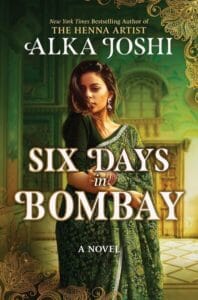Amrita Sher-Gil was an early 20th-century Hungarian Jewish-Indian painter, one of the most celebrated women artists in India of the time. Her father was a Sikh aristocrat and her mother a professional opera singer. She started painting in the western tradition, influenced by the likes of Cezanne and Gauguin, and became known for her paintings of Indian villagers. Sher-Gil died at the young age of twenty-eight, supposedly from a botched abortion. Alka Joshi’s latest novel, Six Days in Bombay, is loosely based on Sher-Gil’s story and is a mystery of sorts set not only in Bombay, but also Prague, Paris, Florence, and London, mainly in 1937.

The six days in the title refer to the time in which Hungarian Jewish-Indian painter Mira Novak—the fictional Sher-Gil—spends in the hospital to recover from a miscarriage she’d at first ignored. Mira’s night nurse at the hospital is an Anglo-Indian woman named Sona Falstaff, known for spending time with her patients beyond administering medicine. She plays cards with a patient named Stoddard, a retired doctor, and soon becomes Mira’s confidante. Mira is lonely in the hospital and is desperate for someone to talk to.
Sona lives at home with her mother and leads a sheltered life. Her father left when Sona was just three to return to his first family in England. She doesn’t feel like she fits with the other Indian nurses at work, but also doesn’t identify as British. When she meets Mira, she admires the way the painter feels at home in both cultures, her Indian and her Hungarian Jewish sides. Mira’s own father lives in Bombay, but is too busy building a synagogue to visit his daughter much in the hospital. Sona can relate.
My eyebrows shot up. As busy as he was building his synagogue, couldn’t Mira’s father find time to visit his only child after she had lost his only grandchild? His absence seemed almost intentional. Cruel, Even. A reminder of my father.
But Mira’s father is jolly, if not absentminded. He feels enthusiastic about this new synagogue and tells Mira that the film star Ruby Myers—another of the historical characters Joshi has inserted into the story —may cut the ribbon at the opening. Also born in Bombay, Myers went by the stage name Sulochana and came from a Baghdadi Jewish family that had settled in India.
As in the real life story of Sher-Gil, Mira ends up dying on her sixth day in the hospital; no one is quite sure what happened other than she overdosed on morphine. Sona is the last nurse to administer Mira’s morphine, but she did not give her more than her prescribed dose. Mira, perhaps knowing the end was near, leaves a note for Sona to deliver three of her paintings to three people from her past—in Prague, Paris, and Florence—and while Sona never imagines actually taking this trip, it does become easier once she’s put on administrative leave for Mira’s mysterious overdose.
When Sona leaves for her trip, she first accompanies her patient, Dr Stoddard, to Istanbul to visit his son in the British foreign service there. The scene at the Bombay dock is full of commotion.
There were a great many people milling about. Bare-chested Indian men in their dhotis carried steamer trunks to the boats. A vendor sliced the tops of his green coconuts with a machete. Workers upended the fruit to pour coconut juice directly into their gullets. A British overseer ordered men to stack cargo onto a waiting bullock cart. A middle-aged Indian woman fried onion bhaji for hungry customers. European women in their ivory dresses, hats and gloves descended the passenger dock of the steamship. British, French and Dutch families were saying goodbye to their seafaring loved ones.
During the first leg of her trip with Dr Stoddard, Sona learns that he also deserted a loved one. He had been engaged to a woman back in England, but broke it off for his life in India, where he married an Indian woman. Sona is conflicted. For so long she despised her father for leaving her mother and her, but now her esteemed friend, Dr Stoddard, also left a woman behind. Stoddard claims he told Sona about his past so she would feel encouraged to look up her father in London as long as she’s traveling as far as Paris.
Before she can decide what to do about that, she makes her first stop in Prague, where she finds Mira’s childhood best friend, another painter named Petra Hitzig. It turns out Mira and Petra had a falling out and Mira wanted to give her old friend a painting to make amends. In an epilogue, there are references to Terezin and Auschwitz.
The first (and titular) part of the story set in Bombay makes up the first third of the novel and may seem like backstory, but it’s the most interesting section of the book. In the European adventures in Prague, Paris and Florence that follow, Sona comes to know more about Mira and herself and eventually comes to terms with her family history. In a conversation in her mind to her deceased mother, Sona muses:


You must be logged in to post a comment.